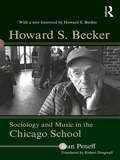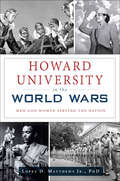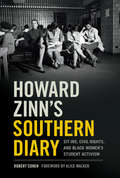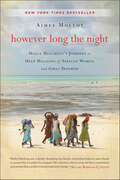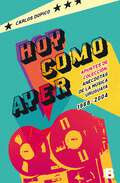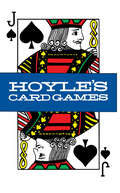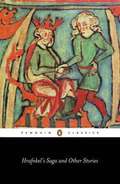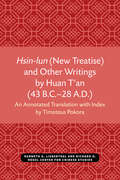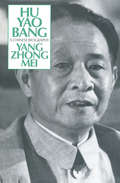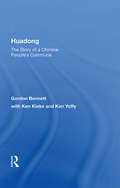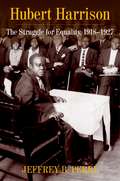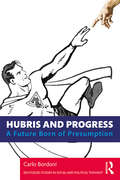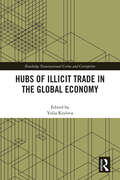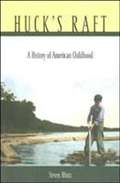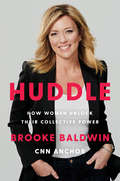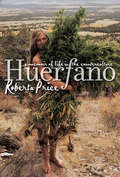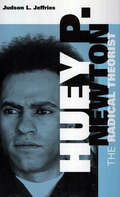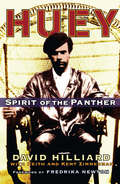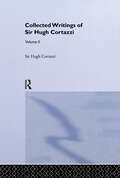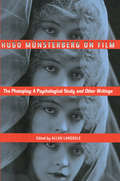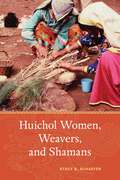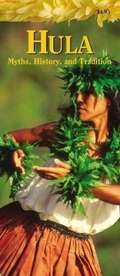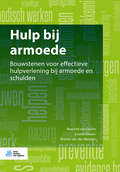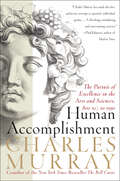- Table View
- List View
Howard S. Becker: Sociology and Music in the Chicago School
by Jean PeneffWho is Howard S. Becker? This book traces his career, examining his work and contributions to the field of sociology. Themes covered include Becker’s theoretical conceptualizations, approaches, teaching style, and positioning in the intellectual milieu. Translated from French by sociologist Robert Dingwall, the English edition benefits from an editorial introduction and additional referencing, as well as a new foreword by Becker himself.
Howard University in the World Wars: Men and Women Serving the Nation (Military)
by Ph.D. Lopez D. Matthews Jr.Despite African Americans' lack of political, social and economic equality in the United States, the students of Howard University answered the call to service in both world wars. Howard supported its men and women in the quest to serve their nation. The university started an army training program during the First World War, and Howard faculty, staff and students pushed the War Department to begin an officer training school for African Americans. The university organized a Reserve Officer Training program in the interwar years, the first at an HBCU. Many of the famed Tuskegee Airmen of World War II were trained first at Howard. Based on a collection of letters sent by Howard students and alumni to the university, historian and archivist Lopez D. Matthews illuminates their wartime experiences.
Howard Zinn's Southern Diary: Sit-ins, Civil Rights, and Black Women's Student Activism
by Robert CohenThe activist and author of A People&’s History of the United States records an in-depth and personal account of the Civil Rights Movement in Atlanta. During the Civil Rights Movement of the 1960s, students of Spelman College, a black liberal arts college for women, were drawn into the historic protests occurring across Atlanta. At the time, Howard Zinn was a history professor at Spelman and served as an adviser to the Student Nonviolent Coordinating Committee. Zinn mentored many of Spelman&’s students fighting for civil rights at the time, including Alice Walker and Marian Wright Edelman. Zinn&’s involvement with the Atlanta student movement and his closeness to Spelman&’s leading activists gave him an insider&’s view of the political and intellectual world of Spelman, Atlanta University, and the SNCC. He recorded his many insights and observations of the time in his Spelman College diary. Robert Cohen presents Zinn&’s diary in full along with a thorough historical overview and helpful contextual notes. It is a fascinating historical document of the free speech, academic freedom, and student rights battles that rocked Spelman and led to Zinn&’s dismissal from the college in 1963 for supporting the student movement.
However Long the Night: Molly Melching's Journey to Help Millions of African Women and Girls Triumph
by Aimee MolloyIn However Long the Night, Aimee Molloy tells the unlikely and inspiring story of Molly Melching, an American woman whose experience as an exchange student in Senegal led her to found Tostan and dedicate almost four decades of her life to the girls and women of Africa.This moving biography details Melching's beginnings at the University of Dakar and follows her journey of 40 years in Africa, where she became a social entrepreneur and one of humanity's strongest voices for the rights of girls and women.Inspirational and beautifully written, However Long the Night: Molly Melching's Journey to Help Millions of African Women and Girls Triumph is a passionate entreaty for all global citizens. This book is published in partnership with the Skoll Foundation, dedicated to accelerating innovations from organizations like Tostan that address the world's most pressing problems.
Hoy como ayer: Apuntes de colección. Anécdotas de la música uruguaya 1968-2004
by Carlos DopicoCarlos Dopico nos propone un viaje emotivo por las canciones y los artistas que son parte de la historia de los uruguayos. Un regreso a la banda sonora de nuestras vidas. La música uruguaya es reconocida por su calidad en todo el mundo. Artistas originales, discos emblemáticos, canciones que se han convertido en himnos, forman parte de un valioso acervo cultural que ha aportado a la construcción de nuestra identidad. Durante muchos años, Carlos Dopico fue un activo partícipe y testigo de la movida musical del Uruguay, dejando testimonio de las luces y sombras de un medio artístico repleto de talento y creatividad, pero sometido a los rigores de un mercado pequeño y con pocos recursos. En este libro se dan cita relatos, anécdotas, testimonios y reflexiones en primera persona que pintan una época. Es un viaje a través de los secretos de las canciones que nos marcaron. Rock, punk, reggae, pop, hip-hop, blues, canción urbana, y otros géneros desfilan por estas páginas, haciéndonos revivir la emoción de la música. Hoy como ayer, la nostalgia y la emoción se traslucen en la escritura certera y reflexiva de Dopico, y en la palabra de los autores de la banda sonora de nuestras vidas.
Hoyles Card Games
by Lawrence H. DawsonFirst published in 1979. Routledge is an imprint of Taylor & Francis, an informa company.
Hrafnkel's Saga and Other Icelandic Stories
by Hermann PalssonTHE stories in this volume date from the thirteenth century, the Golden Age of saga writing,
Hsin-lun (Michigan Monographs In Chinese Studies #20)
by Timoteus PokoraBetter known in his own times than later, Huan T’an (43 BCE–25 CE) was a scholar-official, independent in his thought and unafraid to criticize orthodox currents of his time. A practitioner of the Old Text exegesis of the Classics, he maintained a position on the court during a turbulent time of political crises, uprisings, and civil war, spanning the reigns of four emperors. His principal work, Hsin-lun, differs from other books on political criticism in that it does not deal primarily with history but takes many examples from contemporary social and political life. While belonging to the Old Text group of court officials and scholars, Huan T’an differed radically from them in his stress on direct knowledge, in his range of practical experience, and in his outspoken criticism of popular opinions. He was not a systematic philosopher, but his ideas were influential in the return to a more worldly conception of Confucianism. To translate Huan T’an’s writings, one must reconstruct the texts. Timoteus Pokora uses two nineteenth-century fragments as a basis around which to orient quotations from Hsin-lun from sixty-four other sources, primarily encyclopedias and commentaries. Pokora provides notes to give context to these short references and to account for discrepancies between quotations and originals, and he includes a large index to add coherence and points of entry.
Hu Yao-Bang: A Chinese Biography
by Zhongmei YangCompares IT parks within the Asian Pacific in search of strategies that policy makers can adopt to: reduce the global digital divide; advance distributional equity; and soften some of the negative effects of economic globalization. "Best practices" are suggested based on these cases.
Huadong: The Story Of A Chinese People's Commune (Westview's Special Studies On China And East Asia)
by Gordon BennettThis concise report on one commune in China's innovative commune system is designed to present key features of the system as a whole. It focuses on the concept of the commune in Chinese Communist Party policy and covers Huadong's government and politics, economy, society, and culture.
Hubert Harrison: The Struggle for Equality, 1918–1927
by Jeffrey B PerryThe St. Croix–born, Harlem-based Hubert Harrison (1883–1927) was a brilliant writer, orator, educator, critic, and activist who combined class consciousness and anti-white-supremacist race consciousness into a potent political radicalism. Harrison’s ideas profoundly influenced “New Negro” militants, including A. Philip Randolph and Marcus Garvey, and his work is a key link in the two great strands of the Civil Rights/Black Liberation struggle: the labor- and civil-rights movement associated with Randolph and Martin Luther King Jr. and the race and nationalist movement associated with Garvey and Malcolm X.In this second volume of his acclaimed biography, Jeffrey B. Perry traces the final decade of Harrison’s life, from 1918 to 1927. Perry details Harrison’s literary and political activities, foregrounding his efforts against white supremacy and for racial consciousness and unity in struggles for equality and radical social change. The book explores Harrison’s role in the militant New Negro Movement and the International Colored Unity League, as well as his prolific work as a writer, educator, and editor of the New Negro and the Negro World. Perry examines Harrison’s interactions with major figures such as Garvey, Randolph, J. A. Rogers, Arthur Schomburg, and other prominent individuals and organizations as he agitated, educated, and organized for democracy and equality from a race-conscious, radical internationalist perspective. This magisterial biography demonstrates how Harrison’s life and work continue to offer profound insights on race, class, religion, immigration, war, democracy, and social change in America.
Hubris and Progress: A Future Born of Presumption (Routledge Studies in Social and Political Thought)
by Carlo BordoniThis book explores the ancient question of why man seeks to go beyond his limits. A presumptuous tendency known by the ancient Greeks as hubris and believed to be punished by the gods, it developed from a need for our survival to a habit, as humanity has subdued animals, dominated nature, increased knowledge and sought even to overcome death. It also lies behind the crisis of our time, as the values of democracy, freedom, equality and progress have been weakened – sacrificed to excess, as we live in an eternal present, dominated by greed and indifference regarding the future. Addressing this crisis of our interregnum period, in which faith has been lost in the former certainties of modernity, such as science, progress and the idea of a better world, the author considers whether redemption for humanity might lie in our hubristic tendencies, as these give us scope to deviate from the existing path and find new ways forward.
Hubs of Illicit Trade in the Global Economy (Routledge Transnational Crime and Corruption)
by Yulia KrylovaThis book meticulously examines how centers of illicit trade pose myriad threats to global security and sustainable development. The exponential growth of illicit trade, resulting in annual losses amounting to trillions of dollars for the global economy, is increasingly concentrated within specific geographic areas. These locales serve as safe havens for smugglers and their accomplices, fostering a criminal ecosystem that facilitates the convergence of various criminal activities. The book underscores the detrimental impact of poorly regulated international free trade zones, which prioritize expediency over security, thereby allowing illicit trade to flourish in regions characterized by opaque governance and lax regulatory oversight. It comprehensively explores the spectrum of illicit trade present in notorious hubs such as the Argentina-Brazil-Paraguay Tri-Border Area, Dubai, Panama, Belize, Guatemala, and Ukraine. Emphasizing the phenomenon of crime convergence associated with these hubs, the book offers actionable recommendations for disrupting their interconnected illicit supply chains, infrastructures, and networks. By addressing this interconnectedness, the book fills a critical void in understanding how vulnerabilities within the global economy fuel the creation of illicit trade hubs. It will be of great value to researchers in the fields of trade, economics, criminology, and international development. It will also be an excellent resource for government agencies, policymakers, and private-sector managers in those industries most affected by the growing problem of illicit trade.
Huck's Raft: A History of American Childhood
by Steven MintzLike Huck's raft, the experience of American childhood has been both adventurous and terrifying. For more than three centuries, adults have agonized over raising children while children have followed their own paths to development and expression. Now, Steven Mintz gives us the first comprehensive history of American childhood encompassing both the child's and the adult's tumultuous early years of life. Underscoring diversity through time and across regions, Mintz traces the transformation of children from the sinful creatures perceived by Puritans to the productive workers of nineteenth-century farms and factories, from the cosseted cherubs of the Victorian era to the confident consumers of our own. He explores their role in revolutionary upheaval, westward expansion, industrial growth, wartime mobilization, and the modern welfare state. Revealing the harsh realities of children's lives through history--the rigors of physical labor, the fear of chronic ailments, the heartbreak of premature death--he also acknowledges the freedom children once possessed to discover their world as well as themselves. Whether at work or play, at home or school, the transition from childhood to adulthood has required generations of Americans to tackle tremendously difficult challenges. Today, adults impose ever-increasing demands on the young for self-discipline, cognitive development, and academic achievement, even as the influence of the mass media and consumer culture has grown. With a nod to the past, Mintz revisits an alternative to the goal-driven realities of contemporary childhood. An odyssey of psychological self-discovery and growth, this book suggests a vision of childhood that embraces risk and freedom--like the daring adventure on Huck's raft.
Huddle: How Women Unlock Their Collective Power
by Brooke BaldwinCNN news anchor Brooke Baldwin explores the phenomenon of “huddling,” when women lean on one another—in politics, Hollywood, activism, the arts, sports, and everyday friendships—to provide each other support, empowerment, inspiration, and the strength to solve problems or enact meaningful change. Whether they are facing adversity (like workplace inequity or a global pandemic) or organizing to make the world a better place, women are a highly potent resource for one another. Through a mix of journalism and personal narrative, Baldwin takes readers beyond the big headline-making huddles from recent years (such as the Women’s March, #MeToo, Times Up, and the record number of women running for public office) and embeds herself in groups of women of all ages, races, religions and socio-economic backgrounds who are banding together in America. HUDDLE explores several stories including:The benefits of all-girls learning environments, such as Karlie Kloss’s Kode with Klossy and Reese Witherspoon’s Filmmaker Lab for Girls in which young women are given the freedom to make mistakes, and find their confidence.The tactics employed by huddles of women who work in male-dominated industries including a group of US veterans/Democratic Congresswomen, a huddle of African-American judges in Harris County, Texas, and an all-female writers room in Hollywood.The wisdom of huddling from trusted pioneers such as Gloria Steinem, Billie Jean King, and Madeleine Albright as well as contemporary trailblazers like Stacey Abrams and Ava DuVernay. How professionals such as Chef Dominique Crenn and sports agent Lindsay Colas use their success to amplify other women in their fields. The ways huddles of women are dedicated to making seismic change, including a look at Indigenous women saving the planet, the women who founded Black Lives Matter, the mothers fighting for sensible gun laws, America’s favorite female athletes (Megan Rapinoe, Hilary Knight, and Sue Bird to name a few) agitating for equal pay, and female teachers rallying to improve their working conditions.The bond between women who practice self-care and trauma healing together, including the women who courageously survived sexual abuse, and the women who heal together in The Class and GirlTrek.The ways women are becoming more intentional about the life-saving power of friendship, including the bonds between military wives, new moms, and nurses getting through the time of Covid.Throughout her examination of this fascinating huddle phenomenon, Baldwin learns about the periods of huddle ‘droughts” in America, as well as the ways that Black women have been huddling for centuries. She also uncovers how huddling can be the “secret sauce” that makes many things possible for women: success in the workplace, effective grassroots change, confidence in girlhood, and a better physical and mental health profile in adulthood. Along the way, Baldwin takes readers through her own personal journey of growing up in the South and climbing the ladder of a male-dominated industry. Like so many women in her field, she encountered many sharp elbows on her career path, but became an early believer in adding more seats to the table and huddling with other women for strength and solidarity. In the process of writing HUDDLE, Baldwin learns that this seemingly new phenomenon is actually something women have been doing for generations—a quiet, collective power she learns to unlock in her transformation from journalist to champion for women.
Huerfano: A Memoir of Life in the Counterculture
by Roberta PriceIn the late 1960s, new age communes began springing up in the American Southwest with names like Drop City, New Buffalo, Lama Foundation, Morning Star, Reality Construction Company, and the Hog Farm. In the summer of 1969, Roberta Price, a recent college graduate, secured a grant to visit these communities and photograph them. When she and her lover David arrived at Libre in the Huerfano Valley of southern Colorado, they were so taken with what they found that they wanted to participate instead of observe. The following spring they married, dropped out of graduate school in upstate New York, packed their belongings into a 1947 Chrysler Windsor Coupe, and moved to Libre, leaving family and academia behind. Huerfano is Price's captivating memoir of the seven years she spent in the Huerfano ("Orphan") Valley when it was a petrie dish of countercultural experiments. She and David joined with fellow baby boomers in learning to mix cement, strip logs, weave rugs, tan leather, grow marijuana, build houses, fix cars, give birth, and make cheese, beer, and furniture as well as poetry, art, music, and love. They built a house around a boulder high on a ridge overlooking the valley and made ends meet by growing their own food, selling homemade goods, and hiring themselves out as day laborers. Over time their collective ranks swelled to more than three hundred, only to diminish again as, for many participants, the dream of a life of unbridled possibility gradually yielded to the hard realities of a life of voluntary poverty. Price tells her story with a clear, distinctive voice, documenting her experiences with photos as well as words. Placing her story in the larger context of the times, she describes her participation in the antiwar movement, the advent of the women's movement, and her encounters with such icons as Ken Kesey, Gary Snyder, Abbie Hoffman, Stewart Brand, Allen Ginsburg, and Baba Ram Dass. At once comic, poignant, and above all honest, Huerfano recaptures the sense of affirmation and experimentation that fueled the counterculture without lapsing into nostalgic sentimentality on the one hand or cynicism on the other.
Huey P. Newton: The Radical Theorist
by Judson L. JeffriesHuey P. Newton's powerful legacy to the Black Panther movement and the civil rights struggle has long been obscured. Conservatives harp on Newton's drug use and on the circumstances of his death in a crack-related shooting. Liberals romanticize his black revolutionary rhetoric and idealize his message. In Huey P. Newton: The Radical Theorist, Judson L. Jeffries considers the entire arc of Newton's political role and influence on civil rights history and African American thought. Jeffries argues that, contrary to popular belief, Newton was one of the most important political thinkers in the struggle for civil rights. Huey P. Newton's political career spanned two decades. Like many freedom fighters, he was a complex figure. His international reputation was forged as much from his passionate defense of black liberation as from his highly publicized confrontations with police. His courage to address police brutality won him admirers in ghettos, on college campuses, and in select Hollywood circles. Newton gave Black Power a compelling urgency and played a pivotal role in the politics of black America during the 1960s and 1970s. Few would deny that Newton's life (1942-1989) was strewn with incidences of violence and that his police record was long. But Newton's struggles with police took place in a rich and troubled context that included urban unrest, police brutality, government repression, and an intense debate over civil rights tactics. Stripped of history and interpretation, the violence of Newton's life brought emphatic indictments of him. Newton's death attracted widespread media attention. However, pundits offered little on Newton as freedom fighter or as theoretician and activist. Huey P. Newton: The Radical Theorist dispels myths about Newton's life, but the book is primarily an in-depth examination of Newton's ideas. By exploring this charismatic leader, Jeffries's book makes a valuable contribution to the scant literature on Newton, while also exposing the core tenets and evolving philosophies of the Black Panther Party.
Huey: Spirit of the Panther
by Kent Zimmerman David Hilliard Keith Foreword by Fredrika NewtonHuey P. Newton remains one of the most misunderstood political figures of the twentieth century. As cofounder and leader of the Black Panther Party for more than twenty years, Newton (1942-1989) was at the forefront of the radical political activism of the 1960s and '70s. Raised in poverty in Oakland, California, and named for corrupt Louisiana governor Huey P. Long, Newton embodied both the passions and the contradictions of the civil rights movement he sought to advance. In this first authorized biography, Newton's former chief of staff David Hilliard and best-selling authors Keith and Kent Zimmerman team up to tell the WHOLE story of the man behind the organization that FBI director J. Edgar Hoover infamously dubbed "the greatest threat to the internal security of the country. "
Hugh Cortazzi - Collected Writings: Carmen Blacker, Hugh Cortazzi And Ben-ami Shillony (Collected Writings of Modern Western Scholars on Japan #Vol. 2)
by Hugh CortazziSpecial areas: biographies, history, cultural exchange, arts, business and foreign affairs.
Hugo Munsterberg on Film: A Psychological Study and Other Writings
by Hugo Münsterberg Allan LangdaleHugo Münsterberg's The Photoplay (1916) is one of the first and most important early works of film theory. Münsterberg's work on the emerging art of cinema remains a key document for film scholars, but it has long been out of print. In this new edition, Allan Langdale provides a critical introduction to the seminal text and collects numerous hard-to-find writings on film by Münsterberg.
Huichol Women, Weavers, and Shamans
by Stacy B. SchaeferFor centuries the Huichol (Wixárika) Indian women of Jalisco, Mexico, have been weaving textiles on backstrap looms. This West Mexican tradition has been passed down from mothers to daughters since pre-Columbian times. Weaving is a part of each woman&’s identity—allowing them to express their ancient religious beliefs as well as to reflect the personal transformations they have undergone throughout their lives. In this book anthropologist Stacy B. Schaefer explores the technology of weaving and the spiritual and emotional meaning it holds for the women with whom she works and within their communities, which she experienced during her apprenticeship with master weavers in Wixárika families. She takes us on a dynamic journey into a realm of ancient beliefs and traditions under threat from the outside world in this fascinating ethnographic study.
Hulp bij armoede: Bouwstenen voor effectieve hulpverlening bij armoede en schulden
by Roeland Van Geuns Lisette Desain Rianne van der WeijdenDit boek bevat de resultaten en kennis van zes jaar onderzoek door het lectoraat Armoede Interventies van de Hogeschool van Amsterdam. Het geeft antwoord op de vragen: hoe motiveer je mensen om hun gedrag onder de loep te nemen en te veranderen? En: hoe sluit je zo goed mogelijk aan bij de vaardigheden en wensen van de klant? Het boek richt zich op professionals en beleidsmedewerkers op de terreinen van Armoede en Schulden, zoals schuldhulpverlening en maatschappelijk werk. Daarnaast is het bestemd voor studenten van de opleidingen Sociaal Juridische Dienstverlening, Sociaal Pedagogisch Werk, Maatschappelijk werk en Dienstverlening en Toegepaste Psychologie. Hulp bij armoede: Bouwstenen effectief armoedebeleid en schuldhulpverlening geeft de actuele stand van zaken rondom het onderwerp. Gezien vanuit de wetenschap, de beroepspraktijk en de innovatie. In de praktijk krijgen social professionals uiteenlopende vragen over schulden en financiën. Daarnaast zien zij mensen die hun financiële situatie en vaardigheden niet problematiseren, terwijl daar vanuit professioneel oogpunt wel reden voor is. U leest - aan de hand van voorbeelden uit de praktijk - welke bouwstenen die social professionals kunnen gebruiken om gezond financieel gedrag te bevorderen en armoede en schulden terug te dringen. Het boek illustreert hoe interventies opgezet kunnen worden, waaraan ze zouden moeten voldoen en welke resultaten daarmee geboekt worden. Hulp bij armoede is opgebouwd uit verschillende artikelen. Elk artikel wordt ingeleid met een casus, zodat de lezer weet om wat voor soort klant het gaat en hoe de theorie aansluit bij de dagelijkse praktijk. Verschillende auteurs werkten mee aan deze bundel. De hoofdredactie van Hulp bij armoede bestaat uit Roeland van Geuns, sinds 2012 werkzaam als lector Armoede Interventies en daarnaast als zelfstandig adviseur, Lisette Desain als senior-onderzoeker verbonden aan het lectoraat Armoede Interventies en Rianne van der Weijden als docent verbonden aan de opleiding Sociaal Juridische Dienstverlening en als docent-onderzoeker aan het lectoraat Armoede Interventies.
Hum Aise Bane (Parisar Adyayan Bhag-2) class 5 - Maharashtra Board: हम ऐसे बने (परिसर अध्ययन भाग-२) ५वीं कक्षा - महाराष्ट्र बोर्ड
by Maharashtra Rajya Pathyapustak Nirmiti Va Abhysakram Sanshodhan Mandal Puneपाठ्यपुस्तक परिसर अध्ययन भाग 2 (पाँचवीं कक्षा) का उद्देश्य छात्रों को इतिहास और नागरिक शास्त्र का गहन ज्ञान देना है। इसमें इतिहास की वैज्ञानिक पद्धतियों, कालखंड विभाजन, और मानव की विकास यात्रा का वर्णन किया गया है। पाठ्यक्रम आदिमानव से लेकर आधुनिक मानव तक की प्रगति को समझाने पर केंद्रित है। यह कालमापन, प्राकृतिक संसाधनों का उपयोग, और विभिन्न संस्कृतियों के योगदान की व्याख्या करता है। पुस्तक छात्रों को पर्यावरणीय समस्याओं, सामाजिक समरसता, और नागरिक कर्तव्यों की शिक्षा देती है। इसमें स्वाध्याय, उपक्रम, और चित्रों के माध्यम से छात्रों की रुचि बढ़ाने के प्रयास किए गए हैं। इतिहास को एक विज्ञान के रूप में प्रस्तुत करते हुए, यह प्राचीन सभ्यताओं, उनके साधनों, और मानव जीवन में प्रौद्योगिकी के प्रभाव की भी चर्चा करती है। शिक्षा को आनंददायक और बाल केंद्रित बनाने के लिए यह पुस्तक महत्वपूर्ण संसाधन प्रदान करती है।
Human Accomplishment: The Pursuit of Excellence in the Arts and Sciences, 800 B.C. to 1950
by Charles Murray“Readers . . . are sure to enjoy [the] arguments and elegant presentation” of this “engaging” cultural survey by the controversial co-author of The Bell Curve (Kirkus Reviews).“At irregular times and in scattered settings, human beings have achieved great things. Human Accomplishment is about those great things, falling in the domains known as the arts and sciences, and the people who did them.’So begins Charles Murray’s unique account of human excellence, from the age of Homer to our own time. Murray compiles inventories of the people who have been essential to the stories of literature, music, art, philosophy, and the sciences—a total of 4,002 men and women from around the world, ranked according to their eminence.The heart of Human Accomplishment is a series of enthralling descriptive chapters: on the giants in the arts and what sets them apart from the merely great. Charles Murray takes on some controversial questions. Why has accomplishment been so concentrated in Europe? Among men? Since 1400? He presents evidence that the rate of great accomplishment has been declining in the last century, asks what it means, and offers a rich framework for thinking about the conditions under which the human spirit has expressed itself most gloriously. “Well-written and informative.” —Publishers Weekly
